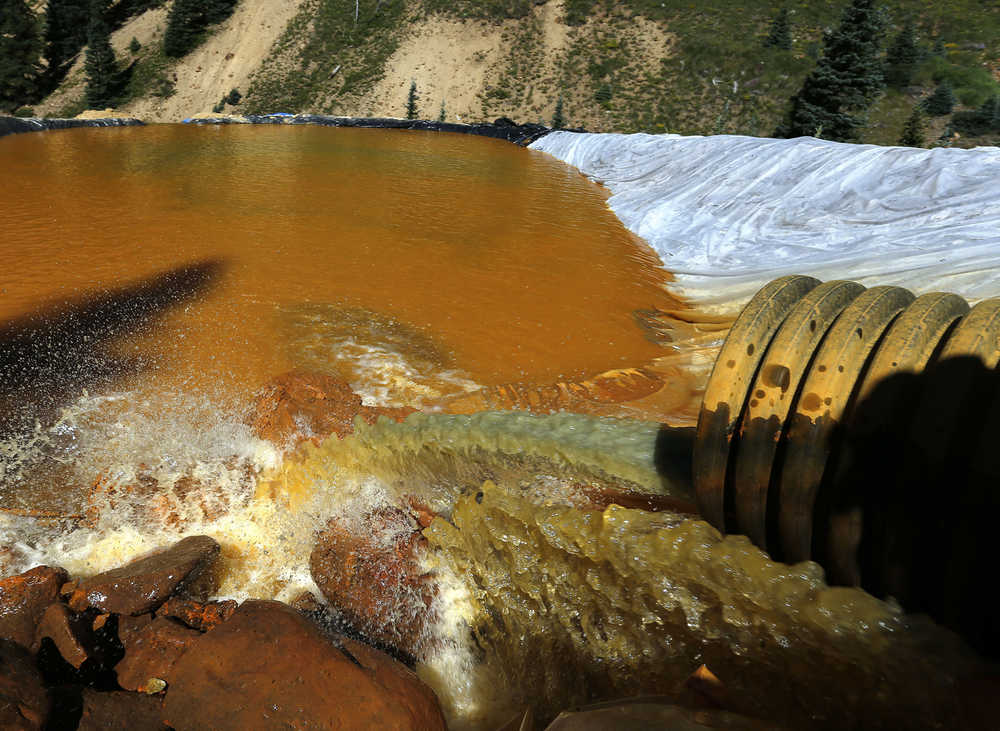BILLINGS, Mont. — Government investigators squarely blamed the U.S. Environmental Protection Agency on Thursday for a 3 million-gallon wastewater spill from a Colorado gold mine, saying an EPA cleanup crew rushed its work and failed to consider the complex engineering involved, triggering the very blowout it hoped to avoid.
The spill that fouled rivers in three states would have been avoided had the EPA team checked on water levels inside the Gold King Mine before digging into a collapsed and leaking mine entrance, Interior Department investigators concluded.
The technical report on the causes of the Aug. 5 spill has implications across the United States, where similar disasters could lurk among an estimated hundreds of thousands of abandoned mines that have yet to be cleaned up. The total cost of containing this mining industry mess could top $50 billion, according to government estimates.
The root causes of the Colorado accident began decades ago, when mining companies altered the flow of water through a series of interconnected tunnels in the extensively mined Upper Animas River watershed, the report says.
EPA documents show its officials knew of the potential for a major blowout from the Gold King Mine near Silverton as early as June 2014. After the spill, EPA officials described the blowout as “likely inevitable” because millions of gallons of pressurized water had been bottling up inside the mine.
The Interior report directly refutes that assertion. It says the cleanup team could have used a drill rig to bore into the mine tunnel from above, safely gauging the danger of a blowout and planning the excavation accordingly. Instead, the EPA crew, with the agreement of Colorado mining officials, assumed the mine was only partially inundated.
“This error resulted in development of a plan to open the mine in a manner that appeared to guard against blowout, but instead led directly to the failure,” according to engineers from Interior’s Bureau of Reclamation, who spent two months evaluating the accident.
The blowout tainted rivers in Colorado, Utah, New Mexico, and on the Navajo Nation with dangerous heavy metals including arsenic and lead, temporarily shutting down drinking water supplies and cropland irrigation.
The report stops short of assigning fault to any individuals, despite prior claims from EPA Administrator Gina McCarthy that it would determine fault and any negligence.
A U.S. Army Corps of Engineers official whose review of the conclusions was included in the report expressed “serious reservations” over the EPA’s failure to explain exactly how its communications broke down and why its officials were so insistent on starting work without more information about the complexities involved.
Richard Olsen, a senior geotechnical engineer with the Corps, also questioned why a change in the EPA coordinator for Gold King led to an “urgency to start digging” even though another EPA official had expressed some uncertainty.
The second EPA official in July asked for an outside review of the agency’s plans by one of the Bureau of Reclamation engineers involved in Thursday’s report. A meeting between the EPA, state officials and the engineer was scheduled for Aug. 14 — nine days after the blowout.
EPA officials pointed out that the mine plug already was leaking and could have eventually blown out anyway, and the Interior report acknowledged that was possible.
EPA spokeswoman Nancy Grantham said the report “will help inform EPA’s ongoing efforts to work safely and effectively at mine sites as we carry out our mission to protect human health and the environment.”
A separate investigation is pending from the EPA Inspector General’s Office.
Members of Congress seized on the report to slam the government’s handling of the spill. But whereas Republicans such as U.S. Sen. Cory Gardner of Colorado focused their ire on the EPA, U.S. Sen. Michael Bennet, also of Colorado and a Democrat, repeated his call for industry reforms to speed mine cleanups.
Guidelines for cleaning up abandoned mines focus on details such as water sampling and treatment. Yet they have “little appreciation for the engineering complexity,” and require but don’t receive significant expertise, the Interior Department’s 132-page report concluded.
Plugging abandoned or inactive mines has been common industry practice for more than a century. The report lists 31 mines across the U.S. where so-called bulkheads were installed since the 1950s to stem the flow of water into or out of a mine.
With coal mines, monitoring and cleanups are funded in part by a fee companies pay. No such arrangements exist for inoperative hard-rock mines, and that’s a national problem, the report noted.
Given industry opposition to efforts to hold mine owners accountable, the cleanup has been left to a scattering of federal and state agencies, without common standards or even lists of the most problematic mines.
In the wake of the Gold King spill, EPA temporarily halted some work at 10 polluted mining complexes in Montana, California, Colorado and Missouri because of similar conditions.
Abandoned hard-rock underground mines are not subject to the same federal and state safety requirements other mining operations must follow, and “experience indicates that they should be,” the report concluded.
“A collapsed flooded mine is in effect a dam, and failure must be prevented by routine monitoring, maintenance, and in some cases remediation. However, there appears to be a general absence of knowledge of the risks associated with these facilities. A comprehensive identification of sites, evaluation of the potential to fail, and estimation of the likely downstream consequences should failure occur, are good first steps in such an endeavor.”

